AI-Generated Case Studies for Retention Marketing
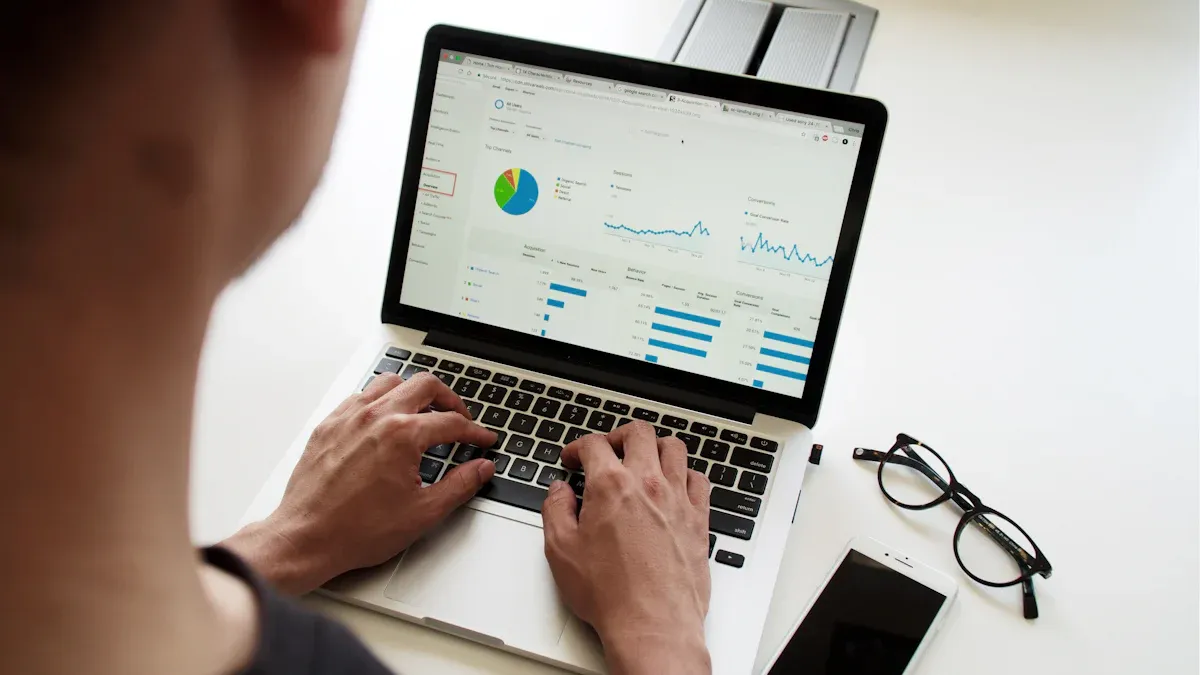
You want your customers to return again and again. AI-Generated Case Studies can help with this. They show real results from businesses like yours. These results use data to prove what works. See how companies use AI to help keep customers:
Company | AI Use | Impact on Retention Marketing |
|---|---|---|
Duolingo | GPT-4 features | 30% more session time, higher renewals |
Salesforce | Personalized marketing with AI | 28% lift in campaign click-through rates |
CarMax | AI-driven content automation | More engagement and better SEO |
Did you know 80% of customers like brands that give them personal experiences? This is why many marketers use AI. Even a small rise in retention—just 5%—can grow your profits by up to 95%. Think about what AI strategies could do for your business.
Key Takeaways
AI-generated case studies share real results from businesses using AI. These businesses use AI to keep customers coming back and to increase sales. Personalization with AI helps customers feel important. This makes them want to visit again and stay interested. AI can help improve content and campaigns. It does this by guessing what customers need and sending messages at the best time. Automated AI tools give quick support and smart marketing. This saves time and makes customers happier. Using best practices with AI, like starting with small steps and keeping data safe, helps keep customers and grow the business.
AI-Generated Case Studies Overview
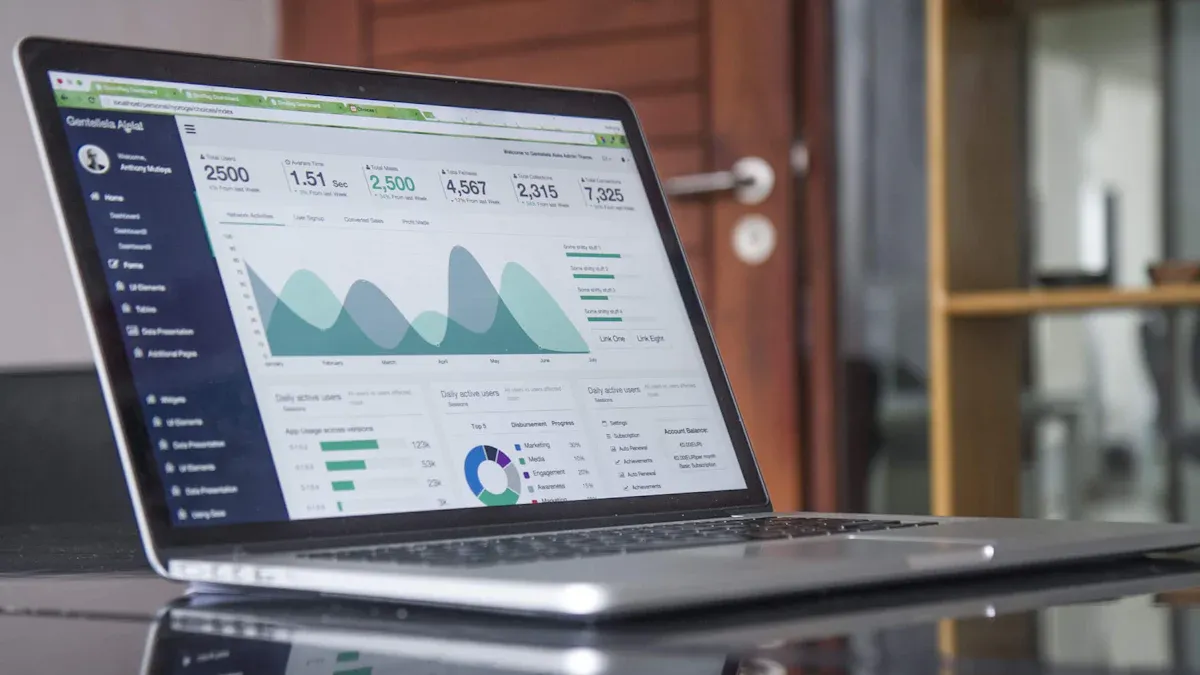
What They Are
AI-Generated Case Studies are stories about how companies use artificial intelligence to fix real problems. These stories show what worked and what did not work. They use real data, not just guesses. You can learn how brands like Netflix, Spotify, and Starbucks keep customers coming back.
When you read these stories, you see how AI can make things feel special for you. Netflix uses AI to suggest shows you might enjoy. Spotify makes playlists just for you. Starbucks uses AI to guess what you want to order next. These stories are not only about big companies. Any business can use AI to learn about customers and help them stay.
Here is a quick look at how some top brands use AI to keep customers:
Company | AI Strategy Description | Numerical Impact on Retention Marketing |
|---|---|---|
Spotify | AI-driven personalized music recommendations (Discover Weekly) | 2.3 billion streams/month; increased engagement and retention |
Starbucks | AI-powered predictive ordering via app | 20% increase in customer engagement; growth in mobile ordering |
Netflix | AI-based personalized content recommendations | 80% of content watched via AI recommendations; significant churn reduction |
Nike | AI for personalized e-commerce shopping experiences | 30% increase in online sales; significant boost in customer loyalty |
L’Oréal | AI virtual beauty consultations | 20% increase in online sales; 25% improvement in customer retention |
You can see that AI-Generated Case Studies give you real numbers and clear results. They help you learn from others and find new ways to keep your own customers happy.
Why They Matter
You might ask why these case studies are important. The answer is easy: they show what really works. When you use AI-Generated Case Studies, you get ideas that are proven by data. You do not have to guess what will help your business. You can see how AI helps companies keep customers, sell more, and build loyalty.
AI lets you make every step of the customer journey feel personal. For example, a recipe website used AI to suggest new recipes. This made people visit 60% more and stay longer. Companies using AI for shopping see 62% of customers buy again. Over 70% of shoppers want offers based on what they bought before. AI helps you guess what customers want and keeps them from leaving.
Did you know? Using AI for personal touches can help telecom companies keep 25% more customers and help big stores lose 40% fewer customers.
AI-Generated Case Studies also show how AI makes your business smarter. You can use predictive analytics to find customers who might leave. Then, you can send them special offers or messages to keep them. This plan works well. For example, online stores using AI for suggestions saw a 30% jump in customers staying. Harvard Business Review found that AI can lower customer loss by up to 15%.
Check out this chart to see how different companies improved retention with AI:
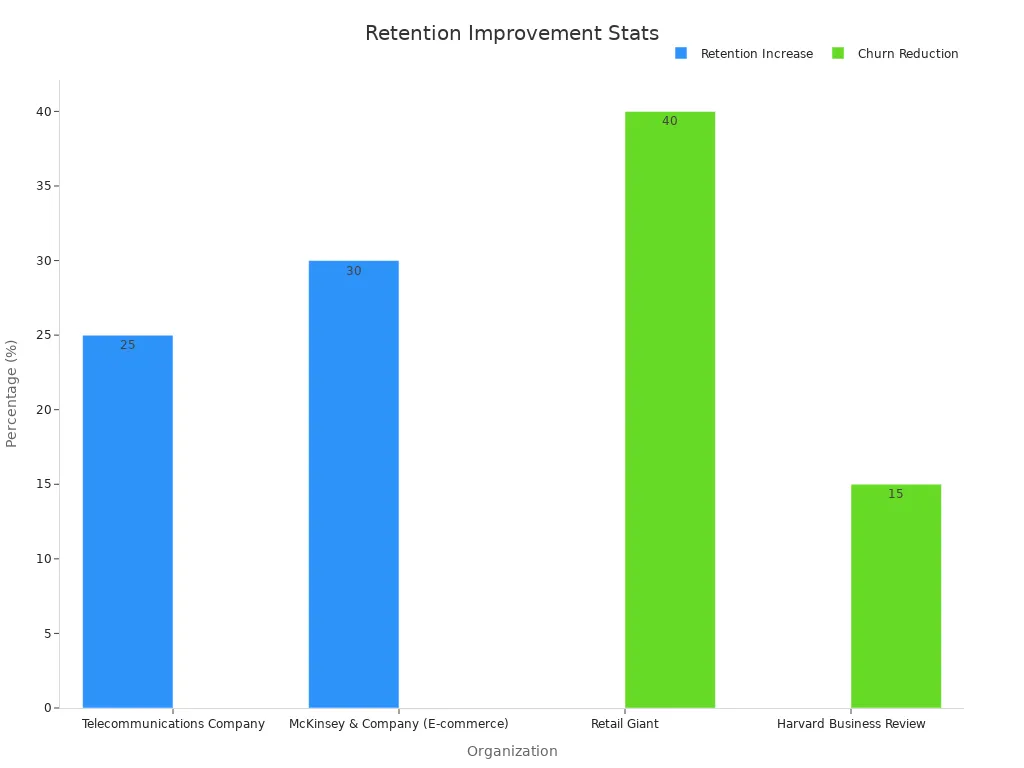
AI-Generated Case Studies help you:
Learn what works for other businesses.
Use real data to make better choices.
Make your marketing personal and keep customers loyal.
Stop customers from leaving before it happens.
Stores using AI see big changes. For example, AI-driven personalization can help keep 22% more customers. Companies using AI for email marketing get 24% more people to open emails. AI-powered analytics can raise marketing ROI by 39%. Most marketing leaders—about 80%—already use AI tools for ads and talking to customers.
Aspect | Statistic / Result | Implication for AI in Case Studies |
|---|---|---|
Personalization (JP Morgan Chase) | 450% increase in click-through rates using AI copywriting | Shows how AI can make content more engaging |
Predictive Analytics (General) | 50% increase in conversion rates leveraging AI predictive analytics | AI helps you make smarter decisions |
Marketing ROI | 39% increase reported by companies using AI analytics | AI improves your return on investment |
Marketing Executives Usage | 80% already using AI tools in advertising strategies | AI is now a must-have in modern marketing |
When you use AI-Generated Case Studies, you get a guide for success. You can see how AI helps companies like yours keep customers, sell more, and stay ahead of others.
Personalization
Customer Journeys
You want your customers to feel important every time they visit. AI helps by following each customer’s path and making it special. Think about Amazon. The website remembers what you like. It shows you things you might want to buy. Netflix gives you show ideas based on what you watched before. Sephora’s chatbot gives you beauty tips just for you. These brands use AI to learn about you and make your visits better.
Here’s how some big brands use AI to make customer journeys personal:
Brand | AI Application | Impact on Retention Strategy |
|---|---|---|
Amazon | Personalized product recommendations based on your shopping habits | Higher satisfaction and more repeat visits |
Netflix | Content suggestions tailored to your viewing history | More time spent watching and fewer people leaving |
Sephora | Chatbots offering beauty advice and product picks | Happier customers and more sales |
Starbucks | App offers based on your preferences, orders, and even the weather | More app use and bigger orders |
Spotify | Playlists like “Discover Weekly” made just for you | More listening and stronger loyalty |
AI does more than just suggest things to buy. It can tell when you might leave and send you a special deal. You get emails that seem written just for you. Some brands, like SalesCloser AI, use smart tools to guess what you want next. This makes you want to come back.
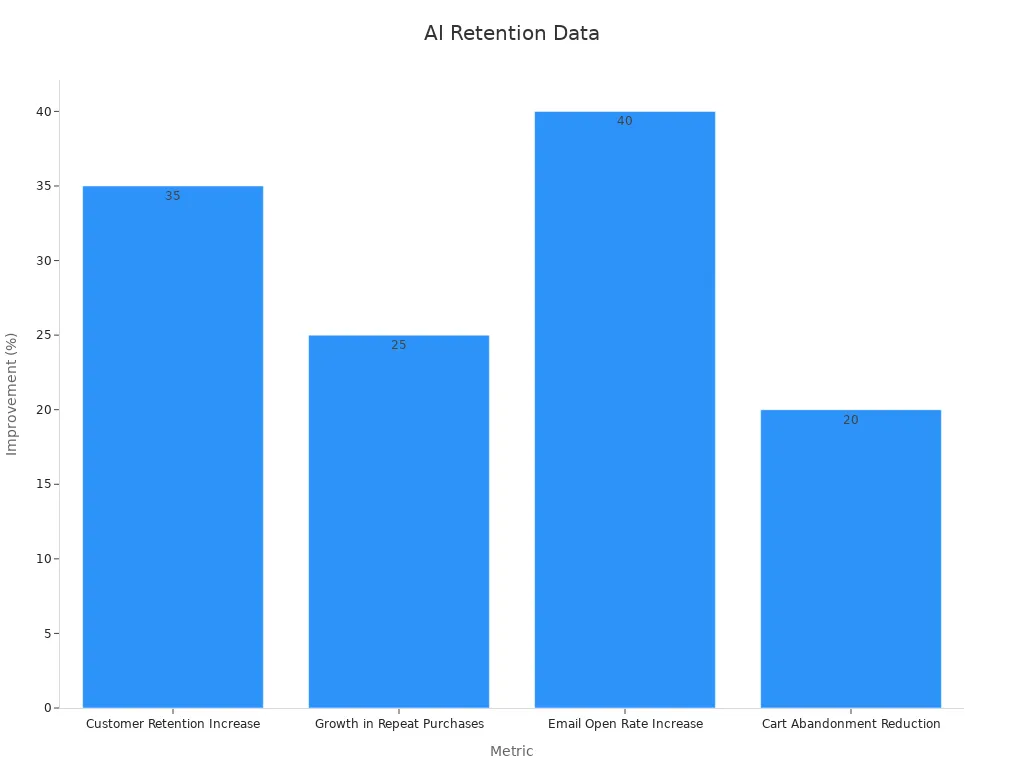
Dynamic Content
AI also helps you see the best message at the best time. When you shop online, the website changes to match your likes. Amazon’s homepage is different for everyone. You get emails with deals on things you care about. This is called dynamic content.
Amazon’s AI picks help make 35% of its money.
Stores using AI can get up to 50% more sales.
Fashion brands see 41% more money from special emails.
Starbucks Rewards sends offers that help people buy more and come back.
Brands using AI-powered personalization see at least a 10% rise in sales. You get more out of shopping, and they get more loyal customers. AI can help stop people from leaving their carts by 20% and make more people open emails by 40%. When you feel like a brand knows you, you want to stay. That is the power of AI-driven personalization.
Content Optimization
Predictive Recommendations
You want your customers to stay interested. AI helps by guessing what they might want next. It checks what people buy and what they click on. It also looks at when they visit your website. Then, AI shows them the best offer at the right time. This makes customers feel special.
Let’s see how some companies use AI for predictive recommendations:
Company / Sector | AI Use Case | Retention / Revenue Impact |
|---|---|---|
HubSpot (SMBs) | AI-powered predictive analytics for engagement tracking | |
Amazon | Dynamic pricing and personalized offers | Pricing updated 2.5 million times/day, boosting repeat purchases |
Uber | AI-powered dynamic pricing | Improved customer retention via personalized offers during high demand |
Prisync (SMBs) | Real-time competitor price monitoring and dynamic pricing | 12% revenue increase through personalized pricing |
Expedia | AI-driven dynamic pricing for travel packages | Increased repeat bookings and customer loyalty |
Airbnb | AI-curated personalized travel recommendations | 20% increase in repeat bookings |
AI helps these companies keep more customers and sell more. Amazon changes prices a lot each day to give good deals. Airbnb uses AI to suggest trips you might like. This makes people want to come back.
Engagement Strategies
AI does more than guess what people want. It also helps you talk to customers in smart ways. AI looks at lots of data, like what people read or skip. Then, it helps you send messages that get attention.
Here are some numbers that show how AI-powered content helps:
Metric | Improvement with AI-Powered Content Optimization |
|---|---|
Conversion Rate Increase | |
Engagement Rate Increase | 83% higher engagement rates |
Email Open Rates | 59% higher email open rates |
Click-Through Rates | 27% higher click-through rates |
43% faster first-page ranking |
Tip: AI can help you write emails people want to open. It can also help your website show up on Google faster.
AI works everywhere—on email, websites, and social media. You reach people where they are with content they like. Companies using AI for customer journeys saw up to a 33% jump in retention. More people come back, and you build better relationships.
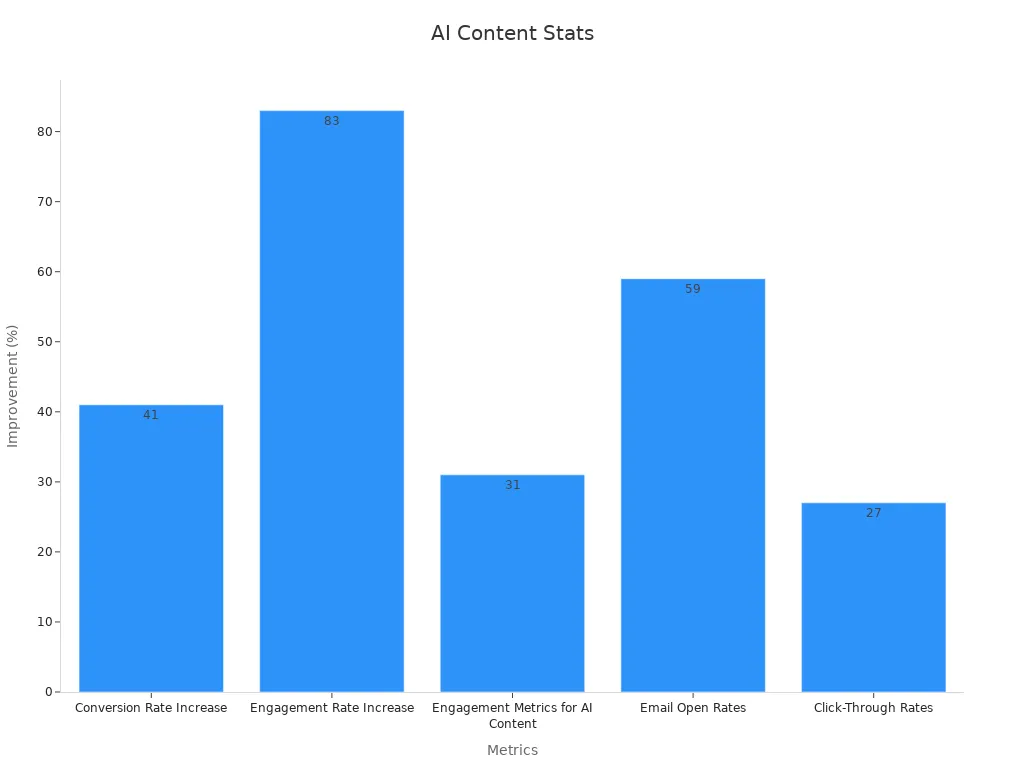
When you use AI to improve your content, every message matters. You keep your customers interested, happy, and loyal.
Customer Engagement
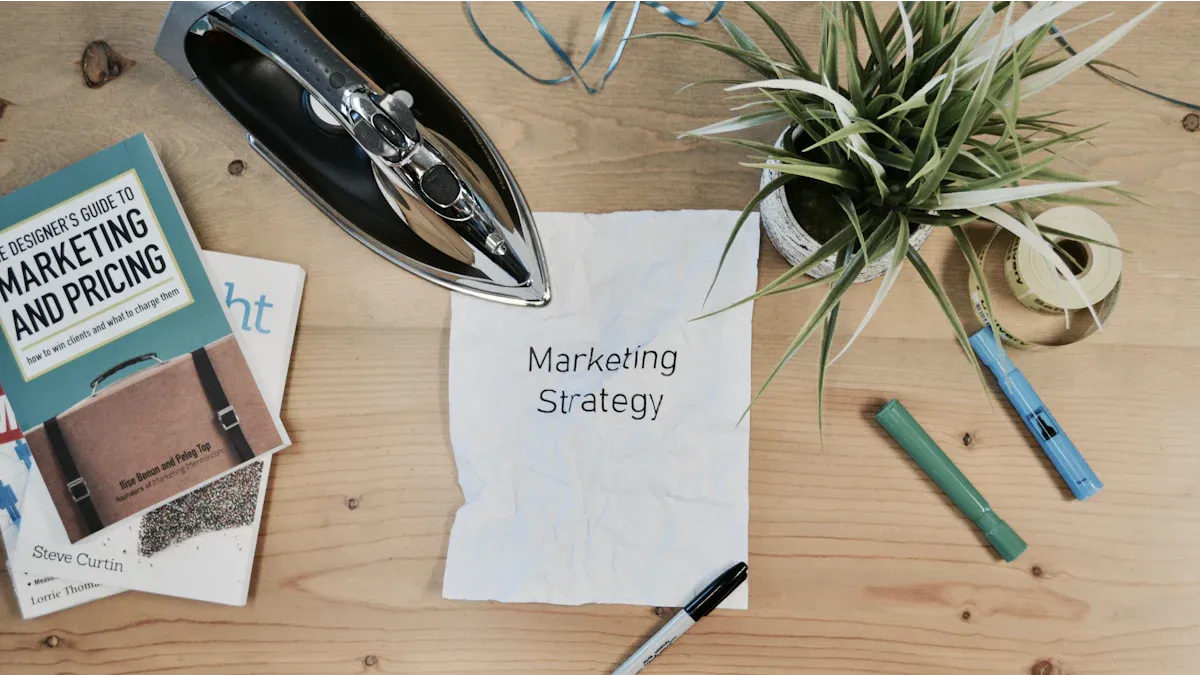
Automated Campaigns
AI helps you reach your customers at the best time. You can set up automated campaigns that work on their own. These campaigns use data to send messages, offers, or reminders. They do this when your customers need them most. You do not have to guess when to contact people. AI watches what your customers do and acts quickly.
Let’s see how some companies use AI for automated campaigns:
Company | AI Application | Key Results |
|---|---|---|
Stitch Fix | Hyper-personalized ads using 30+ data points | 45% more first-time customers; 21% lower acquisition costs |
Sephora | AI-powered visual search for product recommendations | 87% higher engagement; 31% more conversions |
Toyota | Predictive ad targeting with consumer data patterns | 53% more qualified leads; 21% more dealership visits |
AI helps brands talk to the right people and get better results. Tools like Improvado let you watch your campaigns as they happen. You can find problems fast and fix them before they get worse. AI also saves you a lot of time. Marketers say they spend 59% less time running campaigns.
Here are more numbers that show how AI-powered campaigns help:
Metric Description | Statistic |
|---|---|
Average ROI increase with AI campaigns | 76% higher |
Higher conversion rates with AI creatives | 40% more |
Email engagement improvement | 3.5x higher |
Campaign duration improvement | 300% longer effectiveness |
Brand recall improvement | 35% higher |
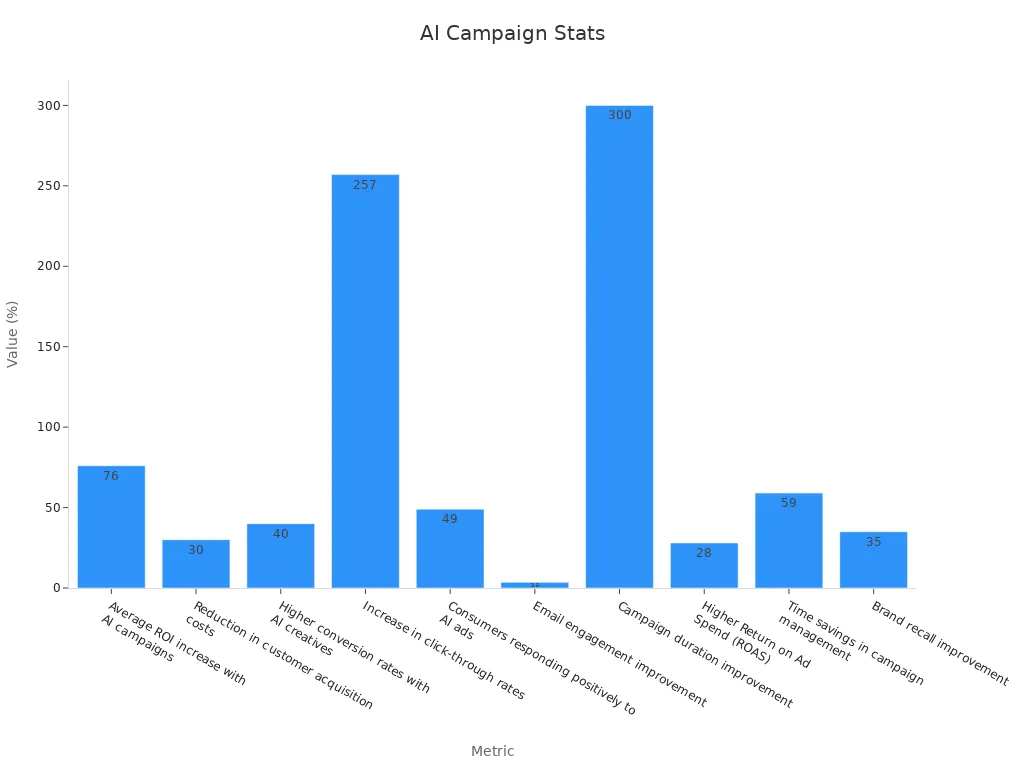
Brands like Sprout Social and AdRoll use AI to pick the best time to post or bid on ads. This can double your conversion rates and cut your costs in half. When AI runs your campaigns, you get more engagement and happier customers.
Real-Time Support
AI does more than help with campaigns. It also gives your customers quick support. Chatbots can answer questions any time, day or night. You do not have to wait for help. This makes your customers feel important and keeps them coming back.
AI checks what customers do after buying and sends follow-up messages.
AI-powered tools know when someone is ready to buy again and send special offers.
Starbucks uses AI to send rewards based on what you like, making you want to return.
DashLX found that brands using real-time AI support can boost loyalty and sales up to five times. You get messages and offers that fit your needs right now. This makes you feel like the brand really knows you.
“We want to be able to target our repeat customers who have purchased a lot, and say, ‘Welcome back! Here's a new product that would go wonderfully with the item you bought last time.’ It would be a wonderful translation of the in-person retail experience where staff know what you like, so they can assist you better.” —Jessica Botello, Customer Service Manager at Manduka
AI also helps your team work faster. Merchants using automation answer 37% quicker and solve problems 52% faster. Brands like Obvi saw three times more purchases from support chats. When you use AI for real-time support, you make every customer feel important and keep them loyal.
Loyalty Programs
Personalized Rewards
You want your loyalty program to feel special for everyone. AI helps by giving each person rewards that fit their likes. You might get a discount on snacks you love or a birthday gift just for you. These small things make people feel seen and important.
Many brands use AI to make rewards just for you. Lancôme gives points when you spend money or share online. You can get invited to events that match your interests. Southwest Airlines lets you earn points for flying and spending. You get better rewards as you fly more. Nordstrom looks at what you buy and offers special things, like a stylist coming to your house.
Brand | Personalized Reward Features | Retention Impact |
|---|---|---|
Lancôme | Points for spending, social sharing, event invites | More repeat purchases and deeper engagement |
Southwest Airlines | Tiered points, status levels, flight and spend rewards | Frequent flyer loyalty and more repeat bookings |
Nordstrom | In-home stylist visits based on customer data | Higher emotional loyalty and increased customer lifetime value |
Warby Parker sends emails with product ideas based on what you bought. American Express gives you a helper for travel or dinner plans, making you feel special. Programs with easy rewards and clear levels make people want to join and keep coming back.
Tip: Simple point systems and rewards for things like birthdays help customers join and stay active.
Retention Impact
Personalized rewards do more than make people happy. They help you keep customers longer. Netflix uses AI to suggest shows you might like. This keeps over 90% of users coming back. It saves Netflix more than $1 billion each year by stopping people from leaving.
Banks using AI for rewards see more customers stay. Some banks see 7-15% more people stay. Others see their money go up by 15-20%. Banks with personal rewards keep 98% of customers. Banks with basic programs keep only 75%.
Here are ways loyalty programs help your business:
People in loyalty programs buy more often and spend more.
Games, badges, and challenges can make people join in 30% more.
Loyal customers tell friends about your brand, bringing in new people.
Watching things like how often people use rewards helps you know what works.
A study found 58% of shoppers spend more because of loyalty programs.
When you use AI for your loyalty program, every customer feels important. This makes them want to come back and helps your business grow.
Measuring Results
Retention Metrics
You want to know if your retention marketing works. AI makes it easy to track the right numbers. When you use AI-generated case studies, you see clear changes in how many customers stay, how happy they feel, and how much they spend over time.
Here’s a quick look at the most important retention metrics:
Retention Metric | Quantitative Improvement / Description |
|---|---|
Churn Rate | AI-powered alerts help you spot at-risk customers and reduce churn |
Customer Lifetime Value (CLV) | AI-driven offers and predictions boost how much each customer spends |
Net Promoter Score (NPS) | Chatbots and dynamic content make customers more likely to recommend you |
Many companies see big results. For example, a SaaS business cut customer loss by 25% in just six months with AI. LiveX AI reports up to 35% lower churn and retention rates that keep climbing. You can also find more chances to upsell—some brands saw a 15% jump after using AI. When you track these numbers, you know what works and where to improve.
Tip: Even a small drop in churn can mean huge savings and more loyal customers.
ROI Insights
You want to see a real return on your investment. AI-powered retention tools deliver strong results. Let’s look at some numbers:
Metric | Experienced AI Adopters | Beginners |
|---|---|---|
Average ROI (%) | 0.2 | |
Typical Payback Period (years) | 1.2 | 1.6 |
PayPal used AI to fight fraud and protect customers. They cut losses by 11% in one quarter. Even as payment volumes doubled, their loss rate dropped by half. AI models helped them move fast and keep customers safe.
Healthcare companies also see big gains. One AI platform saved $1.2 million a year and brought in $800,000 more in revenue. Over five years, the return on investment reached 451%. When you add time savings, ROI jumped to 791%.
Companies with strong data and ethics see ROI over 5%.
Top AI benefits include better customer service, higher profits, and happier teams.
When you use AI for retention, even small changes can mean big wins for your business. Every percent counts!
Best Practices
Implementation Tips
You want to get the most out of AI-Generated Case Studies in your retention marketing. Here’s a simple step-by-step plan to help you start strong:
Spot the Best Tasks for AI
Look for areas where AI can help, like finding patterns in customer feedback or running surveys.Pick the Right Tools
Choose AI tools that match your needs. Make sure they are easy to use and keep your data safe.Get Everyone on Board
Talk with your team about how AI will help and what people still need to do themselves.Start Small
Try AI with a small project first. This helps you see what works before you go bigger.Check and Improve
Always review what AI finds. Use your own judgment to make sure the results make sense.Grow Step by Step
Once you see good results, use AI in more projects to save time and boost results.Keep Learning
Ask your team for feedback. Change your process as you learn what works best.
Tip: Use AI to spot gaps in your data and create better questions for your next study.
You can also use AI for things like lead scoring, dynamic pricing, and sending the right emails at the right time. Brands like Sephora and Santa Cruz Bicycles have seen better customer loyalty and less churn by following these steps.
Data and Privacy
You need to keep your customers’ data safe when using AI-Generated Case Studies. Always check that your AI tools follow privacy rules. Only use data that you really need. Make sure your team knows how to handle private information.
Use clear rules for who can see and use customer data.
Pick AI tools that explain how they use your data.
Review your data often to keep it accurate and up to date.
Combine AI insights with real customer feedback to avoid mistakes.
Note: Keeping data safe builds trust and helps you reach your business goals.
When you follow these best practices, you make your retention marketing smarter and safer. You also show your customers that you care about their privacy.
You have learned that AI-Generated Case Studies can help your business. These stories give proof of better results, like more people clicking on ads, higher engagement, and stronger loyalty from customers. Look at the table below to see some top results:
Benefit | Impact |
|---|---|
Click-Through Rate | |
Social Media Engagement | 63% increase |
Campaign Efficiency | 30% lower costs, 50% faster planning |
User Retention | 35% more listening time on Spotify |
If you want to keep your customers and help your business grow, you should start using AI-Generated Case Studies in your plan now.
FAQ
What is an AI-generated case study?
An AI-generated case study shows how a company uses AI to solve real problems. You see real data, results, and steps. These stories help you learn what works in retention marketing.
How can AI case studies help my business?
You get proven ideas from other brands. You can see what works and what does not. This helps you make better choices and keep more customers.
Are AI-generated case studies only for big companies?
No, you can use them in any business. Small shops, online stores, and big brands all use AI to keep customers happy. You can start small and grow as you learn.
Is my customer data safe with AI tools?
Always check your AI tool’s privacy rules. Pick tools that protect your data. You should use only the data you need and keep it safe.
How do I start using AI in retention marketing?
Try one small project first.
Pick an easy-to-use AI tool.
Watch the results and learn as you go.
Ask your team for feedback.
You will see what works best for you!
See Also
Complete Handbook For Achieving Success In SaaS Marketing
Five Effective Ways To Boost Healthcare Content Marketing
Common Content Marketing Errors Law Firms Should Avoid

